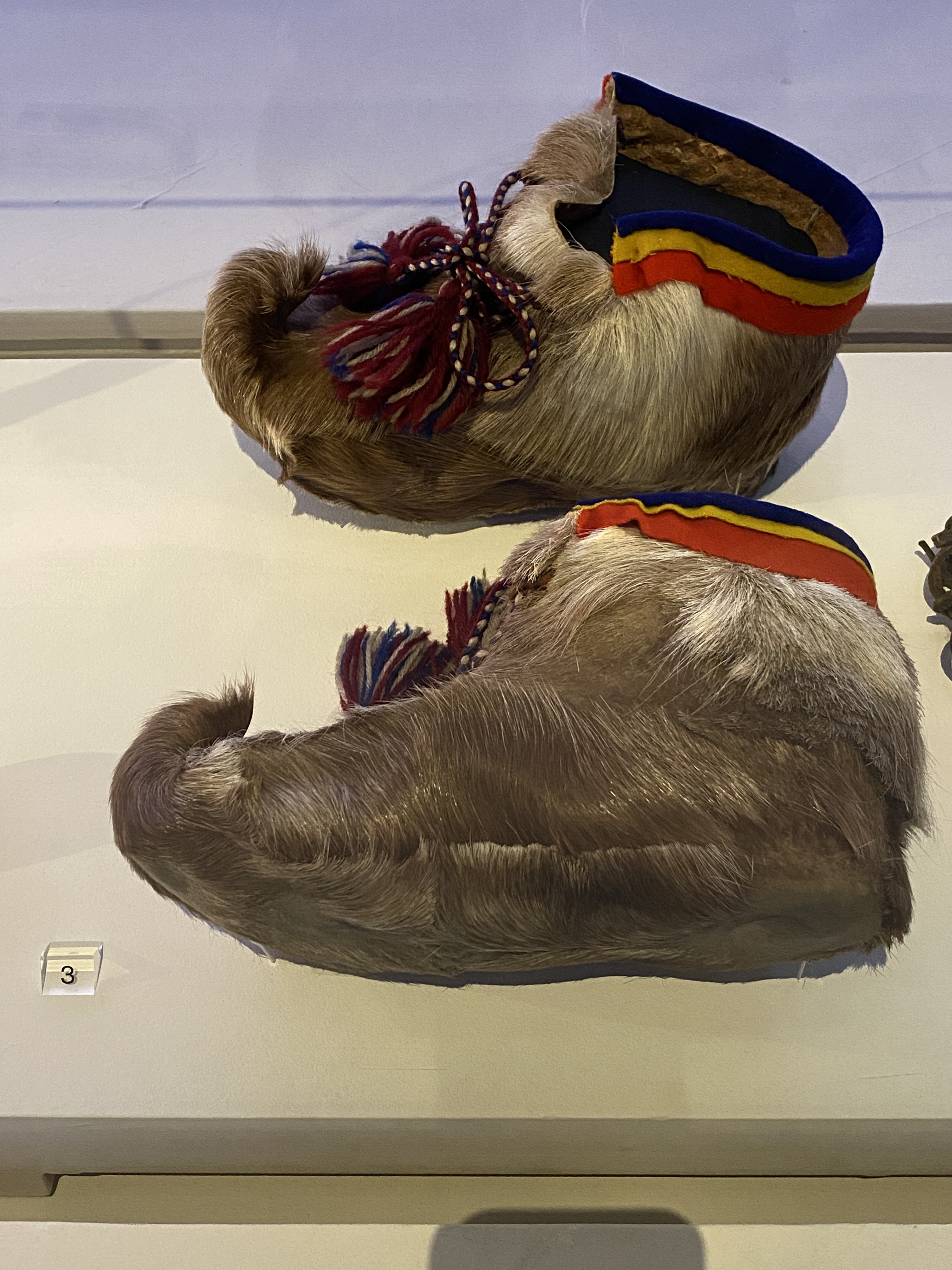Before you even get to the beautiful objects in the new British Museum ‘Arctic: culture and climate’ exhibition it is the statistics that open your eyes to a complex and interconnected world. 4 million people live in the 8 arctic regions – the nations of Russia, USA, Canada, Greenland (Denmark), Norway, Sweden, Finland and Iceland. Of those, 400,000 indigenous people sharing resources, with distinct cultures, surviving in one of the harshest yet most beautiful places on Earth.
What the Arctic exhibition does is go a long way to break down the complexity of different cultures, beliefs and practices and the fragility of a carefully balanced ecosystem.
I like the selection of objects that shows the real understanding of climate and the necessity for survival by the Arctic inhabitants. Not just cold weather footwear, but wooden snow shoes that distribute weight and prevent sinking, Chukchi crampons of walrus ivory for stability on snow that has thawed and frozen again, and Sámi boots with reindeer fur soles, sewn with the fur ends pointing towards the toe to create friction and stop the wearer slipping.

Woman’s winter coat – Nenets, Russia before 1934 
Detail late-autumn hide reindeer 
Sámi boots, Sweden about 1960
This is knowledge not just of the environment but an in-depth understanding of animals and the protection that different parts can offer, such as the winter coat, mittens and boots made from late-autumn reindeer hides used because the fur is at its thickest and has the best insulation.
There are some really unusual objects that capture your attention. I loved the reindeer shaman’s cloak decorated with iron and copper plates that are imbued with spirits for assistance and protection. You can imagine the tinkling noise it would make as the shaman moved, part of the theatre of entering a trance.
The amazing waterproof whaling suit is another show stopper. The only complete example of its kind in the world. Used by a Kalaallit Hunter from Greenland would jump from his boat onto a sleeping whale and harpoon it directly. Crawling in through the central hole, the suit could be inflated through a tube on the chest providing warmth and buoyancy.
It is the craft and utility that reminds you of a people that waste not a single element of the animals they kill to survive. There is a remarkable fishskin bag and eider duck-feet bag. I am always in awe of the skill used to turn seal guts into such beautiful finely stitched clothing. Even the umiaqs – driftwood-framed boats – are covered with seal or walrus hides for flexibility, designed to work with the environment and not fight against it.

Eider duck-feet bag. Zipporah Innuksuk, 1990s 
Seal gut waterproof clothing 
Umiaq boat model 
Fishskin bag. Yupiit, USA. Before 1888. Salmon-skin
I think what stays with me most is the otherworldliness of the images – the ice block men used for target practice in 1920, the haunting photo of a black silhouette against the blinding white snow, and the magic and mystery of shamanic masks, some examples stretch back 1,500 years. A timely reminder of people with different ethnicities, tribes and cultures living in the heart of their environment, the human weather vanes at the forefront of climate change.


Mask belonging to a Nganasan 
Nganasan, from north-west Siberia 
Slat mask from 1,500 years ago 
If I have a niggle about the exhibition it is some displays do more for aesthetics than provide opportunities to really look up close at objects. I love the sculpture by Mtarjuk Attasie Nappaaluk of a family sewing and building a kayak but it is lost in its sunken ice cave. Also the sticky labels in this section are poorly applied and detract from the information in this £18 a ticket exhibition.
These are minor comments on an exhibition with many truly stunning objects that sends out a powerful message not just about what we stand to lose in the face of climate change but the complexities and interconnected relationships of the human, animal and environmental worlds of the Arctic.
xxxxxxxxxxxxxxxxxxxxxx
‘Arctic: culture and climate’ is on at the British Museum from 22nd October 2020 – 21st February 2021 – To book tickets please visit the website – https://www.britishmuseum.org/exhibitions/arctic-culture-and-climate
With thanks to Viking Cruises for the invitation to the preview.













Climate, culture and the Arctic – good link. Thank you 😊